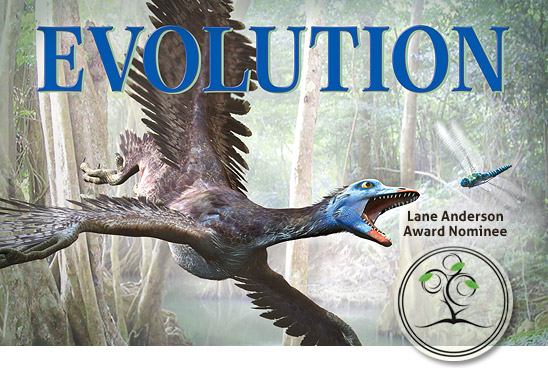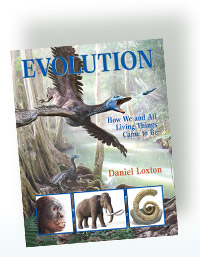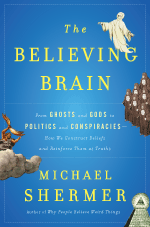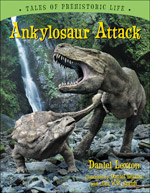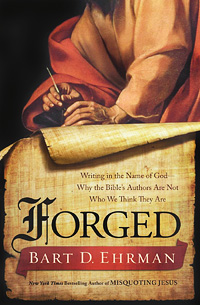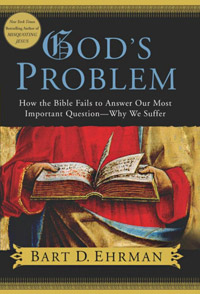In this week’s eSkeptic:
- Nomination: Evolution Nominated as One of Canada’s Top Science Books
- Follow Michael Shermer: 34 Answers About Belief
- Follow Daniel Loxton: Announcing the Release of Ankylosaur Attack!
- Feature Article: A review of Writing in the Name of God
- Upcoming Lecture: Babies Switched at Birth (by Dr. Nancy Segal)
Evolution Nominated as One
of Canada’s Top Science Books
Recently we announced that the Junior Skeptic-based children’s book Evolution: How We and All Living Things Came to Be is a finalist for Canada’s largest children’s non-fiction prize, the Norma Fleck Award. (Winner to be announced Oct 4, 2011.)
Last week it was announced by the National Post, Quill & Quire and other literary media that Evolution is also a finalist for the Lane Anderson Award for Canadian science writing. The Lane Anderson Award honors two top Canadian science books each year—one for adult readers, and one for young readers. Calling Evolution a “tour-de-force of science writing,” the award jury has made Evolution one of just three 2010 Lane Anderson Prize Young Reader Finalists. (Winners to be announced September 14, 2011.)
Author Daniel Loxton responds, “I’m very moved by these nominations, and humbled by the opportunity I’ve had to introduce so many kids to one of the most exciting and important ideas in all of science. I’d like to remind readers that Evolution was born out of Junior Skeptic—which is still skepticism’s most substantial and sustained outreach project for children. I hope you’ll join me in thanking and supporting the Skeptics Society for that groundbreaking educational commitment.”

NEW ON MICHAELSHERMER.COM
34 Answers About Belief
In this YouTube video series for Mahalo.com, Michael Shermer answers 34 questions about belief and rationality. Mahalo.com is an education-based website revolving around original video content filmed in Santa Monica, CA. The site aims to help people learn how to do anything and everything. Among the 34 videos, you’ll find:
- Why do we need a belief in God?
- Why did you write The Believing Brain
- Do you think children should be taught to be more skeptical?
- Is there a psychological difference between open- and close-minded people?
- What are some of the strangest beliefs you’ve ever encountered?
- Is it possible to retrain our brains and belief systems?
- VIEW the entire playlist on YouTube.
WATCH THE VIDEOS on MichaelShermer.com
WATCH THE VIDEOS on YouTube

NEW ON SKEPTICBLOG.ORG
Announcing the Release of
Ankylosaur Attack!
In this week’s Skepticblog, after more than a year of work and months of anticipation, Daniel Loxton announces his new book from Kids Can Press: Ankylosaur Attack! This dinosaur storybook for ages 4 and up features photorealistic art from the Junior Skeptic art team of Daniel Loxton
with Jim WW Smith.

About this week’s feature article
In this week’s eSkeptic, Tim Callahan reviews Forged: Writing in the Name of God—Why the Bible’s Authors Are Not Who We Think They Are by Bart D. Ehrman.
Tim Callahan is Skeptic magazine’s religion editor and author of the books Bible Prophecy: Failure or Fulfillment? and The Secret Origins of the Bible. He has also researched the environmental movement, and his article “Environmentalists Cause Malaria! (and other myths of the ‘Wise Use’ movement)” appeared in The Humanist.
SUBSCRIBE to Skeptic magazine for more great articles like this one.
By Any Other Name
by Tim Callahan
It is widely understood that the gospels designated Matthew, Mark, Luke and John were not written by the various disciples and apostles bearing those names. Instead, these names were rather arbitrarily assigned to the four canonical gospels. It is less widely known that the epistles 1 and 2 Peter were almost certainly not written by that famous disciple of Jesus. Likewise, Jude, supposedly a brother of Jesus, did not write the short epistle bearing his name; and, in all probability, whatever “John” may have written the three epistles and gospel now bearing his name, it was not the “disciple whom Jesus loved” (see the Gospel of John 13:23–25; 19:26; 21:7, 20, 24). Jude can be reliably dated to the 2nd century, past the time any brother of Jesus could have been alive. One reason the disciples Peter and John probably didn’t write the epistles 1 and 2 Peter, 1, 2, and 3 John and the Gospel of John, is that—assuming them to be historical—they were, in all probability, as the biblical scholar Bart Ehrman notes in his new book Forged, illiterate. With illiteracy rates in ancient times estimated to be 90% of the population or more, it is highly unlikely that fishermen were among those who could read or write.
Of course, Paul, as a learned Pharisee and official would have been literate, and a number of the letters bearing his name were, in all probability, written by him. Ehrman notes (p. 93) that at least seven of the Pauline letters are genuinely from his hand. These are Romans, 1 and 2 Corinthians, Galatians, Philippians, 1 Thessalonians, and Philemon. What most of the lay public doesn’t know is that many letters attributed to him, even purporting in their texts to be written by him, were not. These include what are referred to as the Pastoral Letters, 1 and 2 Timothy, and Titus. Additionally, Colossians, Ephesians and 2 Thessalonians were probably not written by Paul, though they, along with the pastoral letters purport to be by him. Thus, of the 13 canonical letters claiming to be written by Paul, nearly half—often referred to as “Deutero-Pauline”—were not, and are, in fact, forgeries.
In Forged, Bart Ehrman deals not only with the evidence that many influential canonical and non-canonical works were forgeries, but also with the inability of many Christian apologists to deal with this embarrassing fact. Rationalizations abound for why 1 and 2 Peter; 1, 2 and 3 John; Jude; and the six Deutero-Pauline letters really weren’t forgeries, even though they were, and really are still inspired, despite the dishonesty of falsely claiming apostolic authorship. Ehrman rather effortlessly tears these rationalizations to pieces, pointing out that most of them are unsupported by even a shred of evidence. Among the rationalizations are the following: It was acceptable in ancient times to write under the name of one’s mentor. The letters were often written by secretaries, who were allowed to add their own words and phrases. It was acceptable in ancient times to write in the name of another, well known author. As to the last of these, Ehrman points out that both forgery and plagiarism, though not illegal in Roman times, were considered reprehensible.
Often, the forgers even put forward a theology in opposition to that held by the apostle whose name they were using. In the case of Paul, both canonical and non-canonical letters and books forged in his name ran the gamut of theological positions, from the intrusive passage inserted into 1 Corinthians telling women to shut up in church (1 Cor. 14:34, 35), followed by 1 Timothy going to great lengths to establish a male dominated hierarchy (1 Tim. 2:11-15) to the non-canonical Acts of Paul and Thecla, in which a female companion of Paul’s named Thecla has great authority and power. The content and teaching of many of the Deutero-Pauline letters, particularly the Pastoral Letters directly contradicts what Paul says 1 Corinthians about marriage. In 1 Cor. 7:25–40, while Paul grudgingly concedes that it isn’t a sin to marry, he sees it as an impediment. Married people are more concerned with pleasing their spouses than having concern for God. Paul also says that, if possible married couples should try to be celibate (1 Cor. 7:29): “I mean, brethren, that the appointed time has grown very short; from now on, let those who have wives live as though they had none.” Written by Paul ca. CE 60, 1 Corinthians echoes the view held by the Christians of that time that their generation would be the last before Jesus returned and the world ended, hence Paul’s obsession with celibacy and renunciation. Yet, 1 Timothy is very concerned about family life and says, despite their many faults, there is a way for them to be saved (1 Tim. 2:15, emphasis added): “Yet woman will be saved through bearing children, if she continues in faith and love and holiness, with modesty.” Ehrman notes that this is in stark contrast to Paul’s bare toleration of marriage and his admonition in 1 Corinthians that the end of the world was nigh.
Just as whole books were forged, sections of books not themselves forged also bear forged sections. These include not only the intrusive passage in 1 Corinthians, mentioned above, but as well a longer ending to the Gospel of Mark, in which there are post resurrection appearances by the risen Christ. Another such intrusion is the much beloved tale in the Gospel of John of the woman taken in adultery. Remove this story from the text and the material before and after it flows smoothly. The story is also missing from the earliest manuscripts of the Gospel of John.
Forgery continues to plague believers to this day through the codification of the New Testament canon. In the final chapter of Forged, Ehrmen deals with a number of popular 19th and 20th century fabrications. Among these is The Unknown Life of Jesus Christ (1894) in which the author, Russian war correspondent Nicholas Notovitch, claimed to have found proof in a Tibetan Buddhist monastery that when Jesus was 13 he joined a caravan to India, studied under Brahmins for six years, learning their holy books, the Vedas, but found himself appalled by the caste system. In order to save himself from being murdered by the Brahmins, Jesus fled to a community of Buddhists and learned Theravada Buddhism. At age 29 he returned to Palestine, armed with the sacred knowledge of the mysterious east. The book and the claims of Notovitch that he found records of the life of the young Jesus in Tibet were a complete hoax. Although it was exposed as such, it nevertheless generated a whole mythos of Jesus visiting India and Tibet and getting his theology from Buddhist monks. Other modern fabrications include The Long-Lost Second Book of Acts, in which Mary the mother of Jesus, teaches the disciples a secret doctrine of reincarnation, The Confession of Pontius Pilate, in which Mary Magdalene presents Roman emperor Tiberius with an Easter egg dyed red, and The Gospel of the Twelve, in which Jesus espouses strict vegetarianism.
One of the strongest points Ehrman makes in this book is that Christian apologists, forced to defend the Bible as divinely inspired, tend to give the canonical forgeries a free pass, avoiding the issue of forgery—meaning lying—through their many rationalizations. As with Ehrman’s earlier books, such as Misquoting Jesus and God’s Problem, Forged is readily accessible to the lay public and clear in presenting the ways in which we know how the Bible was written and who wrote it.
Skeptical perspectives on the Bible…
-
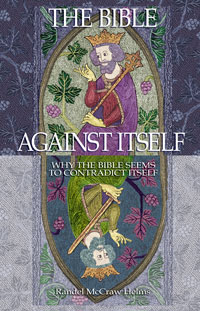 The Bible Against Itself ONLY $7.98!
The Bible Against Itself ONLY $7.98!
by Randel Helms
-
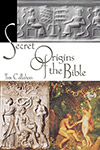 Secret Origins of the Bible
Secret Origins of the Bible
by Tim Callahan
-
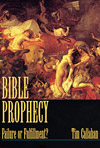 Bible Prophecy: Failure or Fulfillment?
Bible Prophecy: Failure or Fulfillment?
by Tim Callahan

Next at Caltech: Dr. Nancy Segal
Someone Else’s Twin: The True Story
of Babies Switched at Birth
Sunday, September 11, 2011 at 2 pm
IN THIS FASCINATING STORY, Dr. Nancy Segal, Professor of Psychology at California State University, Fullerton (and herself a twin and an expert on twin research) describes the consequences of unintentional separation of identical twins. She considers not only the effects on separated twins, but the implications for questions concerning identity, familial bonds, nature-nurture, and the law. Based on her extensive research into the psychology of twins and interviews with family members, Dr. Segal explores many questions of universal human significance: How do mothers know who their biological children are? How much does our family contribute to our sense of self? Are we more like the people who raised us or the people we are born to? Dr. Segal also examines custodial decisions concerning children who are the result of donated sperm or eggs by individuals outside the rearing family. She further elucidates the benefits to children from adoption.
Ticket information
Tickets are first come first served at the door. Seating is limited. $8 for Skeptics Society members and the JPL/Caltech community, $10 for nonmembers. Your admission fee is a donation that pays for our lecture expenses.


